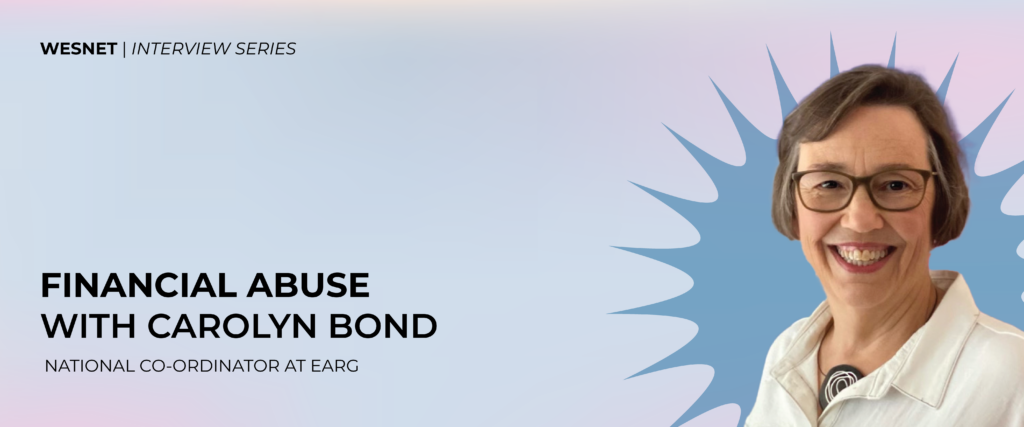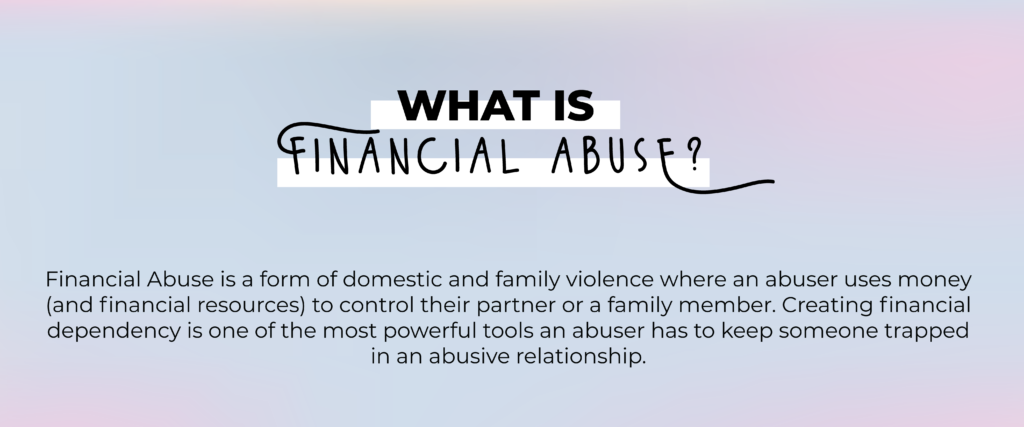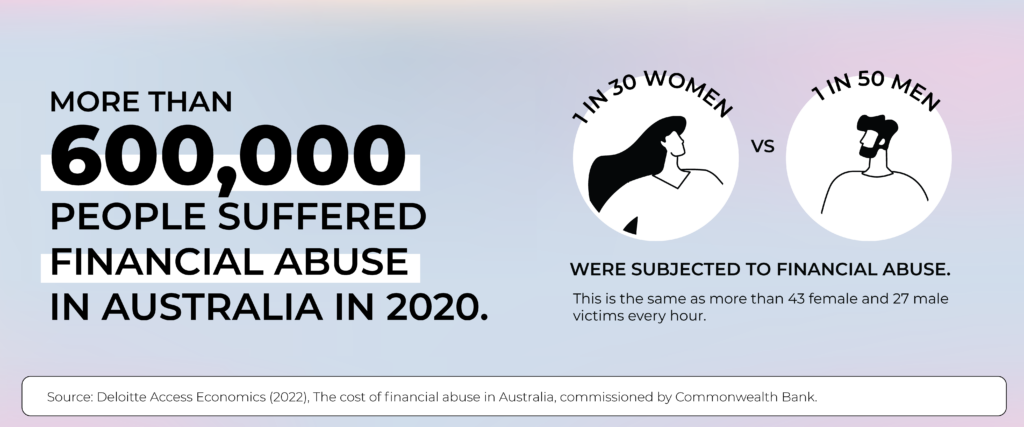WESNET INTERVIEW SERIES
Financial abuse can take many, many forms and is one of the most insidious coercive tools used by abusers to control and manipulate their victims.
The reality of this issue is that financial abuse can strip women from one of their most powerful tools of protection: their independence. More than controlling a woman’s access to money for basic essentials, financial abuse also takes a woman’s voice away and their decision-making rights by denying access to their own bank accounts, denying the ability to gain independent income by preventing her to work or study, or letting their victims in the dark about the financial situation of their own household.
We explored this issue with Carolyn Bond, National Co-ordinator for the Economic Abuse Reference Group (EARG), to bring you more information about financial abuse and Carolyn’s insights on its impacts, origins, areas to address, and some good resources. Read what she had to say below.
1. Thanks, Carolyn, for giving us your time. To start, could you tell us a bit about yourself and how you came to be working in this space?
Hello and thank you for inviting me to your interview. I spent many years working on consumer rights, particularly in relation to financial services (one of my former roles was co-CEO at Consumer Action Law Centre for 7 years). So when I started this role [at the EARG], I knew a lot about banking, insurance and debt problems, but very little about family violence or financial abuse. This role has enabled me to use my consumer rights expertise to fight for changes that help people who’ve experienced financial abuse.
2. Can you tell us about the Economic Abuse Reference Group, who they are and what they do?
We are a network of community organisations which work in the area of financial abuse. We work together to tell businesses and governments how they can change their systems to help customers experiencing financial abuse. Some of our experience includes giving suggestions to the banks, insurance, and energy industries when they developed guides for responding to customers experiencing financial abuse.
One important problem we raised with the insurance industry, for example, was about damage to property done by perpetrators. When a perpetrator damages property, the insurance companies don’t have to pay for the damage if the perpetrator was a joint insured or was invited to the property. While this problem isn’t completely solved, there is now wording in most house insurance policies that says insurers will consider paying such claims, even if they don’t have to under the law.
3. The National Plan to Reduce Violence Against Women and their Children 2010-2022 defined financial abuse as “a deliberate pattern of behaviours in which an individual seeks to control, exploit or sabotage their partner’s ability to acquire, use and maintain financial resources.” We know the understanding of intimate partner abuse is evolving over time. Is this definition still accurate? At a very practical level, what can financial abuse look like? Can we talk about financial abuse without talking about domestic violence?
That’s a long definition, but it sounds right because financial abuse can take many forms. Examples of financial abuse include:
- Preventing the person from accessing their money or resources (such as a car)
- Putting bills in the person’s name so they’re liable for all payment
- Forcing a person to sign for loans which are not for their benefit
- Using the person’s details to get loans or credit cards without their knowledge
- Deliberately incurring fines in the person’s name (e.g. by driving their car)
- Deliberately damaging property
- Preventing the person from working or studying
Financial abuse can happen outside the family (for example abuse by a carer), but when it happens within family or domestic relationships, the law says it is family violence.
4. Okay, so now that we have a better understanding of financial abuse, can you tell us if there is a difference between financial abuse and economic abuse?
The term “financial abuse” is easier for people to understand, so we use that term when talking with the public. “Economic abuse” means the same thing but is used to make it clear that it doesn’t always directly involve finance, but it might involve property or the ability to earn an income. For example, the abuse might involve preventing the use of a car or harassing someone at work to place their job at risk.
5. From what our members report, we know that financial abuse is one of the most powerful coercive tools used by abusers to control and entrap partners but many victims-survivors remain unaware this is a form of abuse. Why do you think this is the case? Are there any clear and consistent red flags leading up to this form of abuse?
Financial abuse, like emotional abuse, can be harder to identify than physical abuse. It often happens gradually, starting with the partner “being helpful” by managing the money, and arranging accounts and insurances.
While couples may choose to have one person doing the day-to-day money management, some red flags of financial abuse could be feeling pressured to borrow money, not feeling able to make decisions about how household funds are spent, or having to explain all the money you spend.
[Financial Abuse] often happens gradually, starting with the partner “being helpful” by managing the money, and arranging accounts and insurances.
6. With more than 600,000 Australians experiencing financial abuse in 2020 (according to the cost of financial abuse in Australia Report), and the costs to the economy and victims being estimated at $5.2 billion and $5.7 billion respectively, the impacts are clearly felt across the community. Taking this into account, what do you think should be the role of governments in preventing financial abuse? Should there be a bigger onus on corporate players, such as banks and credit providers, to detect and prevent abuse? And what would this look like?
There have been a lot of improvements by businesses over the past five years, particularly banks, insurers, and utilities – although some businesses are better than others. Even Transurban, the toll road company, has processes for helping customers who have issues arising from abuse.
However, governments can play a role in ensuring that financial abuse is taken into account in laws and standards. For example, the energy and water laws in Victoria now include requirements for these businesses to have effective processes to assist customers experiencing family violence.
7. The same research showed that nearly 1 in 30 women were subjected to financial abuse compared to 1 in 50 men. Why do you think it is so gendered? What are the long term impacts on individual women and on the achievement of gender equality?
While some men certainly experience financial abuse, it’s likely that the data doesn’t show the full picture. The information we have about financial abuse in Australia is mostly based on surveys, and some studies had found that when given examples of economic abuse “men were more likely to describe non-abusive behaviours…such as ‘frivolous spending’”[1], (which we know it does not constitute either financial or economic abuse).
Women are more likely to experience financial abuse because, on average, they are disadvantaged financially by earning less income, having less superannuation and being more likely to take on caring roles. And, in addition, the duration of the economic abuse tends to be longer on average for women than men.[2] This is combined with some stereotyped attitudes in the community that think men should be in control of the finances and household. So, yes, gender inequality contributes to financial abuse and other forms of family violence experienced by women.
8. Is there anything you would like to see WESNET (as the national peak for domestic and family violence women’s specialist services) do to improve support pathways for practitioners with clients who experience financial abuse?
We have seen good outcomes where different services have worked closely together (such as family violence services, financial counsellors, lawyers, and social workers). Sometimes dealing with financial problems early can prevent a lot of stress and financial pressure later. For example, from debt collectors chasing payment of bills and debts incurred as a result of abuse, to not being able to get a phone service due to a past debt.
One of the challenges is making sure that some of the reforms by businesses and governments benefit the people they’re meant to help. The Victorian Government, for example, funds 21 specialist family violence financial counsellors, and I’d like to see similar programs in other states.
WESNET may have some ideas on how best to get this information to family violence services. More information about this can be found here.
9. Awareness-raising clearly has a role but what else do you think is missing from the current conversation about financial abuse that maybe we are not tackling?
In the long-term, we need to rethink the assumption that couples should have joint accounts (savings, loans, insurance etc) and how they’re dealt with by law. People often think they provide protection for each person, but for most savings accounts one partner can withdraw all the funds without the other person’s authority. One joint insured can cancel an insurance policy without the knowledge of the other person, and a default on a joint loan is registered on both borrowers’ credit reports regardless of who is at fault. While joint accounts are sometimes required (for example to pay for a mortgage), they can cause problems when couples separate – or particularly where there is financial abuse.
We need to rethink the assumption that couples should have joint accounts (savings, loans, insurance etc) and how they’re dealt with by law.
10. And finally, are there resources or tools you can recommend to support someone in building an understanding of financial abuse and how can they protect themselves if they need to?
- The Commonwealth Bank has produced a Recognise and Recover Guide in many languages.
- Free financial counsellors can also help you work out your finances or deal with debts – many have the training to help people experiencing economic abuse. You can find a service in your state by calling National Debt Helpline 1800 007 007 or going to ndh.org.au.
- Of course, financial abuse is a form of family violence so you may wish to contact 1800RESPECT or a family violence service in your area.
About the series: The WESNET Interview Series brings an array of diverse opinions, perspectives and insights from different professionals, practitioners, experts, and advocates on violence against women and girls and other forms of gender-based violence. We aim to share the full diversity of voices to help inform and expand the narratives around ending violence in all its forms. Not all the voices will agree on every aspect of what to do and how to do it, but all the voices are from those committed to ending gender-based violence.
—
Footnotes:



